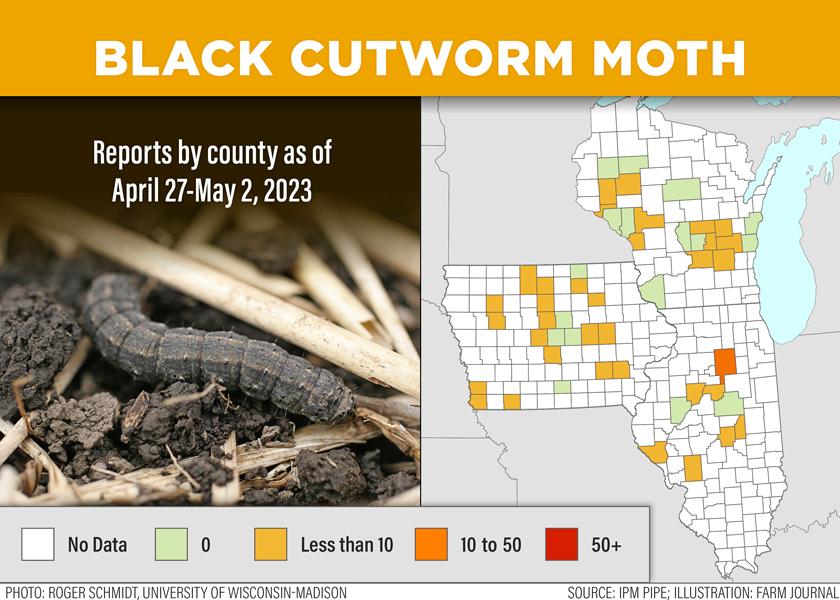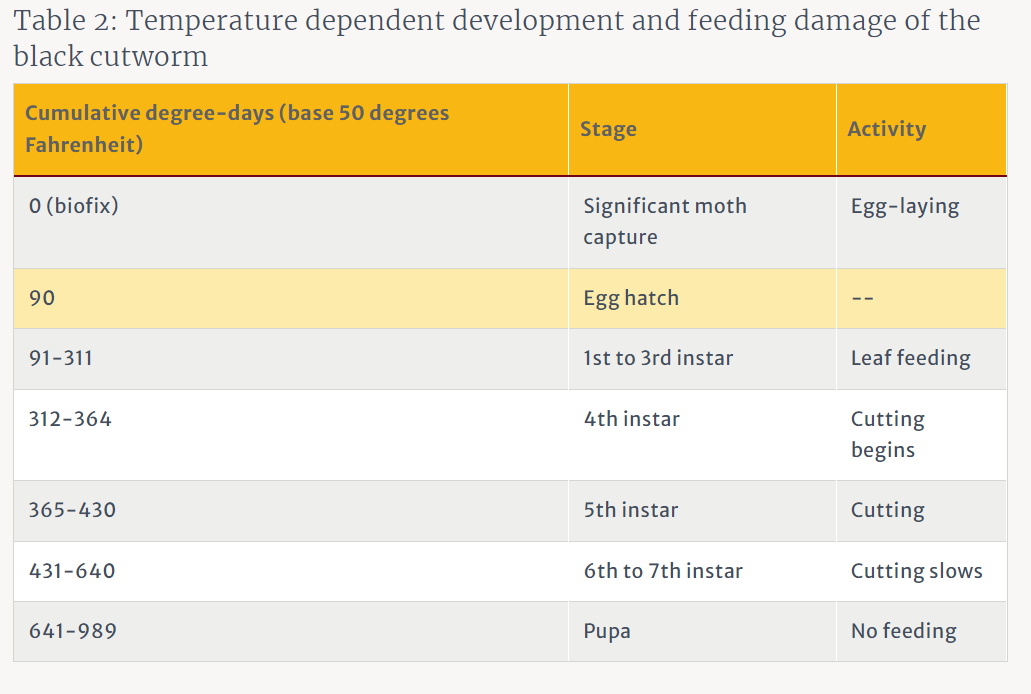Black Cutworm is Moving into the Midwest, Be on the Lookout

Black cutworm moths are on the move from southern climes to northern fields, based on pheromone trapping that’s currently underway in parts of the Midwest.
While the pest has had little to no opportunity yet to feed on corn crops this season, the number of moths caught in pheromone traps indicate feeding will likely be an issue for corn growers.
Later planted fields are often at a high risk of damage, because the corn crop emerges from the soil just as the BCW larvae are hatching and hungry.
What Is A Significant Flight Of Moths?
A significant flight of BCW is whenever eight or more moths are captured over a two-night period. In pheromone traps Ken Ferrie has checked recently he has often found high numbers – between 25 and 30 moths in a two-night period – indicating there is risk to central Illinois corn crops this season.
“The number of BCW found along with weather modeling tell me that central Illinois farmers will start to see cutting in their corn crops around May 23,” predicts Ferrie, Farm Journal Field Agronomist.
Ferrie says farmers who had cover crops, heavy residue or early-season weed pressure in fields need to be vigilant to scout.
“Be checking those fields that had green vegetation,” he advises. “Once black cutworm (BCW) eggs are laid, they're going to hatch and be a problem even if we cleaned up our cover crops or we worked on the weeds in the field and if we're planting a week or two later than usual.”
In Iowa, cutting in corn crops could begin as early as mid-May, according to Ashley Dean, education Extension specialist for field crop entomology at Iowa State University. Dean plans to predict cutting dates for farmers across Iowa and will share the information on ICM News.
Ferrie addresses pheromone trapping and numbers he's found in his latest Agronomic Minute.
Scout For Corn Damage
Black cutworms exhibit two types of feeding patterns depending upon the amount of moisture in the soil and size of corn plants, according to John Tooker, Penn State University entomologist.
“Where soil moisture is adequate and plants are small, the larvae hide in the soil during the day and move to the soil surface at night where they cut off plants just above the soil surface. This is typical damage for most cutworm species,” he says, here.
One larva will cut off an average of five corn plants during its development. In situations of dry soil conditions, the larvae do not move to the surface to feed, but instead, they chew into the plant just below the soil surface. This causes the corn plants to wilt and usually die.
Loss of plants in infested fields will vary from 10% to 80%. Seldom is a field completely destroyed, rather severe damage is usually confined to portions of the field, Tooker says.
Rescue Treatments Are Most Effective And Economical
He says research has clearly shown that scouting to find cut plants and applying rescue treatments if necessary is the most effective and economical way to control black cutworm populations.
University of Missouri Extension says because the level of yield reduction is related to the site of injury on the seedling plants, different corn thresholds exist for damage above and below ground.
Rescue insecticide treatments are recommended when 2% to 4% of the corn seedlings are cut below ground and 6% to 8% percent of the seedlings are fed upon or cut above ground. The smaller percent figure is for lower plant populations (15,000 to 20,000 per acre); whereas, the larger figure is for higher plant populations (22,000 or more per acre). Learn more here.
When To Start Scouting
Degree-days can be used to predict when larvae will be large enough to cause visible damage, begin to cut corn and when they cease feeding, according to Ken Ostlie, Extension entomologist, and Bruce Potter, integrated pest management specialist, University of Minnesota Southwest Research and Outreach Center.
The simple degree-day model for development predicts that larvae are large enough to cut plants when more than 300 degree-days have accumulated after a significant moth flight. They address how to assess degree-days for insects here.
Don’s Assume Bt Hybrids Have You Covered
Bt hybrids containing the Cry1F protein (Herculex /HX1) or Vip3a protein (Viptera), alone or in stacks, are labeled as controlling black cutworm. While they reduce risk, corn might still be damaged under heavy cutworm pressure, Ostlie and Potter say.
An at-plant insecticide is probably not that helpful in preventing additional cutworm stand loss when added on these hybrids. Remember, the Cry34/35 Ab1 (Herculex RW protein) is not the same as the Cry1F above-ground protein.
In addition to timing of tillage, spring weed and cover crop growth, the Bt protein in the planted hybrid can help prioritize fields for scouting. The Handy Bt Trait Table shows which Bt proteins control black cutworm and several other insect species.
Unspoken Truths About Drought-Loving Pests
Unspoken Truth About Pests: Emerging Pest Pressure That Could Come to a Field Near You
Is A Double Whammy of True Armyworm Underway?
Why a New App Designed by Iowa State Could Be a Game Changer to Identify and Diagnose Unwanted Pests
Unspoken Truth About Pests: Why Planting Dates Play a Critical Role in Battling Pests Right Now









